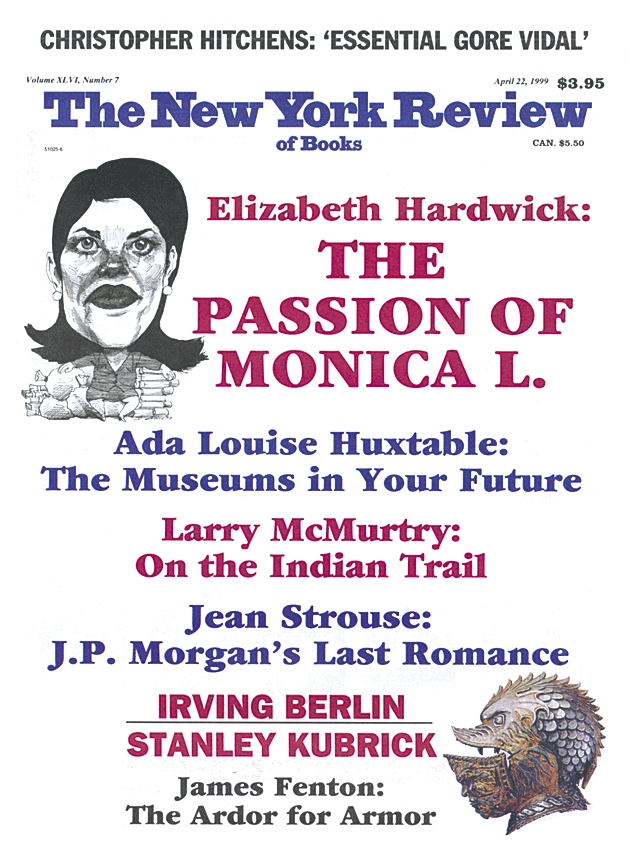“Film is art, and art is play, and making a movie is all fun and play—except the filming,” Stanley Kubrick said. He said he was not fond of actors.
If it is true that his heart stopped a few days after he had at last shown some Warner Brothers executives and his actors—Nicole Kidman and Tom Cruise—his newly completed film Eyes Wide Shut, years in the making, there is something especially uncanny and fateful about what would otherwise be a straightforward tragedy. He had been thinking about this material, based on Schnitzler’s novella Rhapsody, a Dream Novel, for more than twenty years.
He showed the novella to me in 1979 when I was working with him in England on the screenplay for The Shining, an adaptation of Stephen King’s horror novel. The experience of all of Kubrick’s writers has been remarkably similar—driving in his car to the isolated estate, the daily work with a charming and interesting, if demanding, companion. The cars changed—a copper-colored Mercedes stretch when I was there—but the chauffeur Emilio stayed. I had been warned by Terry Southern not to accede to Kubrick’s wish for me to live nearby—“not if you want to call your life your own.” (Kubrick’s description of working with Terry on Dr. Strangelove was, “He would come out from London once a week and shout a few words from the taxi window.”) I went out every day, driven by Emilio.
Kubrick had apparently shown Dream Novel to all the writers he had worked with, to friends, perhaps people at Warner Brothers. He had shown it to others since, over the years, apparently searching for the suggestion that would unlock for him something that drew but puzzled him. For one thing, he was not sure if this Freudian tale of eros, guilt, repression, and death was a comedy or a tragedy. (He leaned toward the comic and, I have heard, explored it with Steve Martin.) Talking to him about it, I remember thinking that the idea that it might be a comedy, clearly not Schnitzler’s view, was a kind of resistance on his part to its erotic content. But perhaps that was not the element he found most unsettling.
Looking back now, whatever his final transformation of the Schnitzler material turns out to be (as yet unknown, except to Kidman and Cruise, the other members of the cast and crew, and the Warner executives who saw it just before his death), one could say that to have conceived of it in terms of comedy would be consistent with his comic and pessimistic view of things in general. Tragedy after all has an optimistic side, paradoxically affirming as it does the dignity of the human being.
But Kubrick had a strong, offended sense of the ridiculousness of the human being, and the futility of human endeavor. He returned to these points again and again—with the recruit in Full Metal Jacket, everyone in Dr. Strangelove (the characters associated with Terry Southern), the victims in A Clockwork Orange. He assailed married life and artistic pretension in The Shining, which was also to have assailed racism (the Overlook Hotel had been built on an Indian burial ground), a theme that fell by the way. The new film may assail psychiatry, another subject he was skeptical of.
His pessimism seems to have arisen from his idealism, an outraged yearning for a better order, a wish to impose perfection on the chaotic materials of reality. This impulse is behind much art, after all, and Kubrick was above all an artist. His art was an expression of his view of things through the complicated medium of film. Like any artist, he felt an interest in controlling as many aspects of his medium as he could—set, music, costume, take—an attitude that unfairly earned him the reputation of monomaniacal difficulty.
But he thought of art as fun. Art in his view was also moral. People have tried to enlist him in the cause of hip nihilism, but this is to mistake his orthodox Sixties but rather conservative views. What was A Clockwork Orange—which he withdrew in England after some copycat killings—but a diatribe against violence? What were Dr. Strangelove and Full Metal Jacket but antiwar films?
It has been some years since I saw him, but do people change after all? In the early 1980s he was a funny, brilliant, well-read eater of Chinese sweet-and-sour ribs and an appreciative watcher of other people’s movies, loyal to old friends, a tender-hearted animal lover, father, and husband, and of course a brilliant filmmaker. He liked dinner parties, and had the reaction of a shy foreigner to meeting well-known English people (“Harold Pinter? Really?”).
People who have worked with him more recently say he was still the same. It is too bad that some have felt impelled, maybe by their love of mystery or from some unexpected resentment, to impose on Kubrick a cloak of misanthropy, reclusive malice, cruelty, solitude. Within the world he had created, his life was happy and complete—a huge estate (house built in the style of a stately home for the former Maples furniture magnate), gardens (overseen by his wife, Christiane Kubrick), children, grandchildren, dogs, and his wonderfully rewarding work. Is it his choosing not to live in America that bothers and puzzles? Why wouldn’t one choose a less violent society with a good educational system as a place to bring up children and grandchildren? A privileged life, but it was a more normal life than he would have had if he had stayed in Hollywood: after all, it incorporated some values Hollywood seems to have forgotten.
Advertisement
This Issue
April 22, 1999


